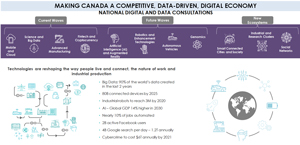 New survey from Microsoft Canada reveals a gap between what business’ leaders say is good for business and their actions.
New survey from Microsoft Canada reveals a gap between what business’ leaders say is good for business and their actions.
Almost two-thirds (61 percent) of Canadian business leaders agree that data — and knowing how to draw actionable insights from that data — are key to business success in today’s economy.
However, only about one-third (34 percent) say their business has a comprehensive data strategy in place and even fewer (31 percent) feel their organization is a data-led business. These are some of the key findings in a new survey from Microsoft Canada, exploring whether business leaders are effectively leveraging data to drive growth and innovation, stay competitive and improve the customer experience.
Microsoft surveyed 658 business decision-makers from Canadian organizations, including public sector, private sector and non-profits and ranging from micro (fewer than 10 employees) to large enterprises (500+ employees).
The survey revealed that there is a significant delta between what business leaders say they need for success and what they’re doing to achieve it. For instance, while 71 percent of those surveyed say their company is either on par within the industry or a leader in its level of digital sophistication, only 4 out of 10 say their organization currently uses the cloud. This despite a near-consensus across global consulting firms which agree the cloud is critical to meet the demands of a modern business. In fact, in a recent study, Deloitte found that cloud adoption is a competitive necessity in today’s economy. Along with low cloud adoption, only a few respondents (34 percent) from Microsoft’s research indicate that making better use of the data they have will be a priority for their organization in the coming year.
“Data has become the most valuable currency for organizations in a digital, cloud-first world,” said Kevin Peesker, president of Microsoft Canada. “Regardless of the size or type of organization, leveraging AI, data and analytics is crucial for Canadian organizations to foster innovation, deliver on evolving customer demands and ultimately stay competitive in the global economy as we continue to recover from the pandemic.”
While nearly half (46 percent) of survey respondents say their organization aims to become more data-savvy, only 34 percent currently use data analytics tools or services. Further, of those not using data analytics tools or services, fewer than a fifth (18 percent) have any plans to adopt such tools in 2022.
“What the findings reveal when it comes to how most business leaders prioritize data as part of their digital strategy is alarming,” says Peesker. “Many organizations invested in technology such as the cloud and AI to manage disruption in response to the pandemic. Time to impact, innovation and secure scalability has been proven. Now, it’s critical for these organizations to optimize their investments to enable real digital transformation. That includes deriving the right insights from the wealth of data available to them so they can compete in their industry and on a global scale.”
Last March, Microsoft announced the creation of the Data Innovation Centre of Excellence (DICE) as part of its new Toronto headquarters opening this year. DICE, Microsoft’s first dedicated data and innovation centre of its kind, will help Canadian private, public and non-profit organizations harness the power of data and cloud technology to accelerate their digital transformation and co-innovate on cutting-edge solutions. To better serve the unique needs of customers and partners within the public sector, Microsoft has established the Microsoft Government Innovation Centre located in Ottawa.
“Organizations that are using their own data to implement solutions tailored to their specific needs, may not only bolster business resilience but also improve operations and become more responsive to evolving citizen and customer demands,” said Peesker. “With DICE, we’re empowering organizations to take advantage of the data they create to develop comprehensive strategies that solve some of their most pressing business challenges and accelerate growth.”
These results are drawn from a survey conducted by Fuse Insights on behalf of Microsoft Canada. A total of 658 business decision-makers from across Canada, representing a range of company sizes and industries were surveyed online in English and French in December 2021.
 An $80 million investment from Innovation, Science and Economic Development Canada will see 29 organizations give 3 million training opportunities to help youth gain coding and digital skills.
An $80 million investment from Innovation, Science and Economic Development Canada will see 29 organizations give 3 million training opportunities to help youth gain coding and digital skills.
Canada needs a workforce that is strong in science, technology, engineering and math (STEM) and capable of taking on challenges to compete in the digital economy. To make sure the next generation of young Canadians can thrive in that digital reality, the Government of Canada is supporting millions of students in improving their digital skills.
François-Philippe Champagne, Minister of Innovation, Science and Industry, announced the 29 organizations across the country that are receiving $80 million in funding in the third phase of the CanCode program.
This investment will enable these organizations to offer 3 million training opportunities for students, from kindergarten to Grade 12, to learn digital skills, like coding, data analytics and digital content development. Since 2017, CanCode has helped provide over 4.5 million coding and digital skills training opportunities to students and over 220,000 to teachers.
This means 7.5 million training opportunities will help millions of young Canadians be better prepared for the jobs of tomorrow. CanCode also helps Canadian teachers acquire the know-how to incorporate new digital skills and technologies into their classrooms. As well, the program has a focus on encouraging under-represented groups, like Indigenous youth, Black youth and girls, to pursue careers in STEM.
CanCode also aligns with Canada‘s Digital Charter, a principles-based approach to building trust in the digital world. The first principle of the Charter is focused on ensuring that all Canadians have equal opportunity to participate in the digital world and the necessary tools to do so, including access, connectivity, literacy and skills.
“To drive our economic success for years to come, we must support young Canadians in the digital world,” said Champagne. “By investing in resources that teach students things like coding and data analytics, we are helping them gain the skills needed to succeed in the 21st century economy. These are the skills that will help them transition from the classroom to research labs, shop floors and boardrooms.”
As announced in Budget 2021, the Government of Canada is investing $80 million in CanCode. This investment is in addition to the $60 million from Budget 2019 and $50 million from Budget 2017.
In its first and second phases, CanCode helped provide over 4.5 million coding and digital skills training opportunities to millions of Canadian students and 220,000 to teachers. This third phase seeks to provide an additional 3 million training opportunities to students and 120,000 to teachers, with a focus on youth from under-represented groups.
CanCode has a student stream and a teacher stream. CanCode funding recipients deliver digital skills learning opportunities for students from kindergarten to Grade 12 and/or training programs and workshops for teachers.
CanCode is designed to complement educational curricula, promote awareness of coding, spark interest in coding and encourage digital skills more broadly. The long-term goal is to make Canada a leading innovation economy with a diverse and inclusive workforce.
In 2019, 27 projects from across Canada received funding from the CanCode program. The organizations receiving funding this year are: Actua; Black Boys Code; BGC Canada (Boys and Girls Clubs of Canada); Brilliant Labs; Canada Learning Code; COlab – Innovation sociale et culture numérique; Cybera; Edmonton Space & Science Foundation; Elephant Thoughts Educational Outreach; FIRST Robotics Canada; Grandir Sans Frontières; Hackergal; Information and Communications Technology Council; Institute for Ocean Research; Kids Code Jeunesse; LAUNCH Waterloo; Let’s Talk Science; MindFuel Foundation; Neil Squire Society; Pinnguaq; Saskatchewan Science Centre Inc.; Saskatoon Industry Education Council Inc.; Science East; Science North; Science World BC (ASTC Science World Society); Taking IT Global Youth Association; The Learning Partnership; University of Winnipeg Foundation; Youth Fusion; Associated links; CanCode; Innovation and Skills Plan.
Data platform modernization delivering richer insights and powering dynamic digital experiences for TD customers.
TD strategic acceleration of the bank’s move to establish an enterprise level data estate on Microsoft Azure. This initiative, that now includes a multi-year agreement with Databricks, will further enhance analytical capabilities to help power new customer experiences and enable employees to collaborate with more agility across the Bank.
The new agreement between TD and Databricks will help TD unlock data at scale and achieve broader benefits with the move to Azure by leveraging Delta Lake for access to high-quality, governed, and secure data across the enterprise.
“At TD, our data and analytics capabilities are central to innovating for our customers in new and meaningful ways,” said Jeff Martin, SVP Corporate Platforms, TD Bank Group. “By consolidating our data onto the Microsoft Azure cloud platform and leveraging Databricks, we are further enhancing and evolving the customer experience and supporting new product development.”
Azure Data Services is a cornerstone of the Bank’s cloud strategy, providing TD data scientists, technologists, and its data analyst community with the tools needed for more efficient and secure access to data, as well as advanced analytics capabilities including Azure Synapse and Azure AI, including Azure Machine Learning.
“Banking is one of the most data-intense industries in the world. Using Azure as its primary cloud platform across all lines of business including their data estate, TD will be able to derive critical and real-time business decisions and unlock new transformative customer insights to build the bank of the future,” said Kevin Peesker, President of Microsoft Canada.
This expansion builds on a longstanding strategic relationship between TD and Microsoft that started with the adoption of Azure as the Bank’s cloud foundation to accelerate and fuel new and innovative banking experiences.
The use of Databricks on Azure will facilitate the democratization of data and will create opportunities for TD colleagues to work with industry-leading tools and meaningfully contribute to the Bank’s customer-centric innovation strategy.
“At Databricks, we believe ensuring data integrity and enhancing collaboration across a bank are key competitive differentiators,” said Junta Nakai, RVP, Global Financial Services. “TD is a global leader in implementing a next-generation data architecture and we’re thrilled to be a part of their innovation journey.”
 Hybrid work is making businesses more vulnerable than ever to cyberattacks says findings from NOVIPRO/Leger Survey – Portrait of Business IT in Canada (6th Edition).
Hybrid work is making businesses more vulnerable than ever to cyberattacks says findings from NOVIPRO/Leger Survey – Portrait of Business IT in Canada (6th Edition).
Canadian IT company, NOVIPRO, unveiled its sixth annual IT Portrait of Canadian Businesses in collaboration with Leger, which revealed the deep vulnerability of Canadian companies to computer attacks. The study reveals that more than half (56 percent) of organizations targeted by malware have paid the amounts requested by cybercriminals. Of these, one of three companies (33 percent) retained the services of a negotiator, while 23 percent proceeded without the help of an intermediary.
And why wouldn’t they pay? Data is a valuable commodity. Sixty percent of companies have sensitive customer data (e.g. confidential information, credit card numbers, social insurance numbers, etc.) and nearly one third (28 percent) value their information assets (data, people, processes, recipes, etc.) at more than $1 million.
“As an entrepreneur, I am very concerned that so many organizations are paying a ransom,” says Yves Paquette, co-founder and CEO of NOVIPRO. “Companies need to be proactive in preventing cyberattacks, otherwise the impact will be devastating to them and their customers. If organizations invested even a fraction of the potential cost of an attack, they could easily put systems in place to guard against such fraud. In the physical world, you’d employ a detachment of guards to protect something with a seven-figure value, however, there still seems to be a disconnect when the ‘something’ is digital.”
Hybrid work breeds concerns about cyberattacks
Our time in the pandemic has revived security concerns. Nearly half (43 percent) of respondents are more concerned about a breach since the introduction of hybrid work, prompting most organizations (76 percent) to take the time to review their security practices, whether it’s providing training to employees (32 percent), developing a telecommuting policy (31 percent) or investing in software (29 percent), to name a few.
Reflecting the feedback from 2020, companies that are victims of cyberattacks once again admit that their employees are the largest source of cyber threats (53 percent). Of these, 31 percent are motivated by malicious intent and 22 percent unintentionally trigger an attack by clicking, for example, on a fraudulent link. Despite this, the percentage of organizations that have trained their teams have continued to steadily decrease for the past three years. Only 40 percent of respondents plan to offer training to their teams on this topic next year.
“The pandemic has forced companies to focus their energies on operational emergencies,” explains Dominique Derrier, Chief Information Security Officer of NOVIPRO. “We see that in 2021 they are more aware of computer threats, but are slow to take significant action. It is imperative that organizations apply the latest infrastructure and engage the right experts to ensure their IT security. Not only are their operations at stake, but their reputations as well.”
Additional findings included:
Work-from-home means cloud computing is here to stay
While the fifth edition of this study found a marked acceleration in cloud adoption by Canadian businesses due to COVID-19, the 2021 data shows that the trend continues. No doubt a sign that telecommuting or telework is becoming permanent, a third of respondents (33 percent) cite it as one of the reasons IT professionals encourage or would encourage companies to opt for cloud computing.
Attraction and retention are the challenges of the day
Not surprisingly, the difficulty of attracting qualified resources (43 percent) and the retention of key personnel (39 percent) are the major challenges for human resources in the IT field. The pandemic has exacerbated these issues as more than a third of organizations have struggled to attract skilled talent (45 percent), retain key resources (36 percent) or engage and motivate teams (31 percent).When the pandemic struck in 2020, more than half of companies wanted their employees to work from home for more than three days per week. One quarter of respondents also intended to allow full-time remote work. Practices have continued to evolve in this area, with 52 percent of companies having reduced the number of days employees are authorized to work from home in 2021.
AI investment is down
More cautious since the pandemic, companies are forecasting less technology investment in the next two years (80 percent) compared to 2020 (88 percent); Ontario companies (85 percent) are planning to invest the most in the next two years. For the second year in a row, investment plans in advanced data analytics and artificial intelligence are declining, falling to 18 percent, from 29 percent in 2020. If Quebec was among the leaders in this sector before the pandemic, it is now the Canadian province with the least focus on AI, while British Columbia (24 percent) is in first place for the first time in six years.
Renewed trust in IT teams
The survey shows that 40 percent of companies have more confidence in their IT team when it comes to security in the wake of COVID-19.
Provincial Variations
While Canadian businesses from coast-to-coast have concerns about ongoing issues with cyberattacks, there are also some interesting regional highlights and differences on the topic:
- Quebec (70 percent) companies were less likely to review security practices due to the pandemic compared to Ontario and British Columbia organizations (82 percent respectively) in 2021.
- Over half of Ontario businesses (56 percent) are more afraid of a cyberattack since the implementation of hybrid work, compared to Quebec (32 percent) who are less concerned.
- 25 percent of respondents say they have already been victims of a computer threat, similar to the previous year. Quebec (24 percent) was the most affected province in 2020, however Ontario (29 percent) has overtaken this spot in 2021.
- Only 12 percent of Canadian companies view their IT as a necessary evil, with Ontario businesses having the highest proportion at 17 percent.
The entire study is available for download from NOVIPRO at http://it-trends.ca/
About the NOVIPRO/Leger 2022 Survey
The data for the sixth edition of the PORTRAIT of IT in Medium and Large Canadian Companies NOVIPRO/Leger comes from a web survey conducted between October 1 and 25, 2021, among 491 respondents, including 288 IT decision-makers, 97 decision-makers who do not work in IT, 81 decision-makers who are neither directors nor IT and 25 NOVIPRO clients. The Portrait surveys Canadian businesses on their IT priorities and challenges. Over the years, the study has highlighted trends in the deployment of artificial intelligence projects, cybersecurity solutions, cloud implementation and IT investment.




